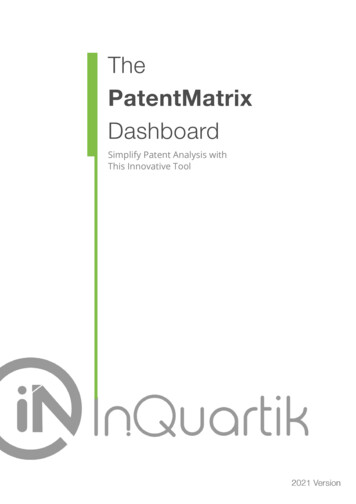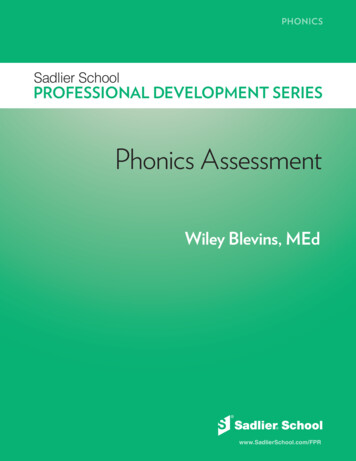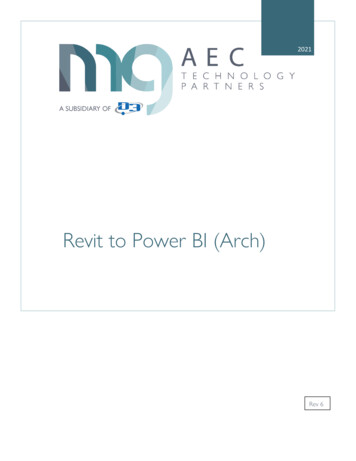
Transcription
ThePatentMatrixDashboardSimplify Patent Analysis withThis Innovative Tool2021 Version
Table of ContentsContentsPatent Analysis: Then and Now3What is the PatentMatrix Dashboard?4More Powerful Than a Pivot Table5Completely Customizable Patent Analysis Data5Combined Hierarchical Processing5A Two-Level Axis at Its Core6Effective in Every Aspect of Patent Work7Freedom-to-Operate (Patent Clearance) Search7State-of-the-Art (Patent Landscape) Search7Competitive Intelligence and Patent Portfolio Management8Patent Due Diligence8How to Perform a PatentMatrix Dashboard Analysis10The Analysis Structure10Other Metrics for the Analysis11Data Grouping11Combining the Data Sets13Examples of the PatentMatrix Dashboard17Case 1: Freedom-to-Operate Search17Case 2: Patent Landscape Analysis – Patent Owners and FocusedTechnologies20Case 3: Competitive Patent Analysis – An Overview of a Company’sTechnology and Patenting Activity22Case 4: Patent Due Diligence – Access the Monetization Potential of thePatent Portfolio25Conclusion: A Powerful Tool for Patent Analysis and Insights28
InQuartik The PatentMatrix DashboardPatent Analysis: Then and NowWhether it is to have the right productdevelopment strategy, to deploy the patentportfolio worldwide, or to monetize thepatent assets, people who work in thisfield have developed all kinds of analysisand management methodologies such aspatent landscape, state-of-the-art analysis,competitive intelligence, freedom-to-operate,patent due diligence, as well as patent portfoliomanagement.To speak plainly, Excel may be considered anall-purpose general tool; however, in the patentworld, it is necessary to have a more purposeoriented tool for all scenarios. InQuartik’sPatent Vault, along with the PatentMatrixDashboards, is the right tool for every patentprofessional in every scenario. It reduces theuse of multiple tools and increases the speedof your analysis, allowing you more time toreflect and plan your next steps.While conducting these analyses, peopleusually use the pivot table in Microsoft Excel.We cannot deny that Microsoft Excel is one ofthe most popular software globally, but whenit comes to the patent world, not everyone issatisfied with the operation or usability.The most common issue is that multiple toolsare often required for the complete analysis.Besides, you may need to organize multipledata fields in a spreadsheet, and spend a lotof time managing data integrity and accuracy;once all of these menial tasks have beencompleted, you may no longer have enoughtime for the actual data analysis.These tedious processes made patentwork even more complicated: Emails needed to communicate Cloud storage services needed toshare patent list files and analysiswith colleagues Excel needed to organize the dataand conduct analysis3
InQuartik The PatentMatrix DashboardWhat is the PatentMatrix Dashboard?When it comes to patent data, basic statistical charts do have their place, especially when itcomes to calculating one dimension of the data.However, when it comes to categorizing by industry, product, or technology, basic charts oftenfall short of the task. This is where a pivot table comes into play.Not just any pivot table will do. What is needed is a PatentMatrix Dashboard, with the robustcapabilities required to handle a wide range of data and several types of categories.4
InQuartik The PatentMatrix DashboardMore Powerful Than a Pivot TableCompletely Customizable Patent Analysis DataTo make effective patent analysis a reality, a PatentMatrix Dashboard isneeded.This Matrix allows certain data aspects—such as the product or technology—to be visualizedclearly by integrating them into a pivot table, representing patent data in a hierarchical way.The key is to make the data or fields in the PatentMatrix Dashboard entirelycustomizable for the user.Ease of use is essential. Instead of forcing users to attempt to do this on their own—as wasnecessary in the past—the customization of the data must be incorporated right into the Matrixand should be achievable in just a few clicks.Combined Hierarchical ProcessingBy utilizing hierarchical processing—such as a tree structure—patent data can be organizedby product, technology, or field of application, for example.This information on its own, however, does not provide much meaning. It is only when this datais combined with other data sets that it starts to provide insights through patent analysis.The PatentMatrixOther SystemsMost EffectiveLess xisL3L1 L2X-AxisL1L3L1 L2Hierarchical processing vs. other systems5
InQuartik The PatentMatrix DashboardA Two-Level Axis at Its CoreThe PatentMatrix Dashboard embeds two levels of metrics in both the X and Y axis, enabling youto examine as many as four data fields simultaneously.The benefits of two-level metrics are quite significant: they allow you to view the analysis with anentire perspective or focus on a more specific target from a bird’s-eye view.For example, in a technology structure/patent quality vs. patent office/patent value dashboard,you can see not only the deployment of the patent portfolio but also the patent quality vs. valuedistribution. Moreover, if you just focus on the high-quality and high-value patents, it is easier for youto sort these patents out at a glance.A technology structure/patent quality vs. patent office/patent value dashboard6
InQuartik The PatentMatrix DashboardEffective in Every Aspect of Patent WorkThe PatentMatrix Dashboard can be aneffective tool in just about every type of patentsearch activity, including (but not limited to): Freedom-to-Operate (Patent Clearance)Search State-of-the-Art (Patent Landscape) Search Competitive Intelligence and PatentPortfolio Management Patent Due DiligenceFreedom-to-Operate (Patent Clearance) SearchA Freedom-to-Operate Search, also knownas a Patent Clearance Search, is usedto discover whether it is safe to sell yourproducts or services in a country thatmay already have patents owned by athird-party, and that may have claims thatcontain your product or service.By searching related patents in that country,you are able to lower the infringement risksand prevent wrongful investments.The PatentMatrix Dashboards help applicantsmanage their risk by offering an overview of thetechnologies vs. global deployment. It givespatent professionals a better understanding ofwhat kind of products and technologies havebeen applied for in specific countries.Additionally, the PatentMatrix Dashboardsallow you to examine filing years, patentquality, patent value, or other data in thesecond axis of the same dashboard, thusoffering more insights at the same time. Bymeans of this, applicants can have a biggerpicture of their patent application strategy thanmerely a freedom-to-operate search.State-of-the-Art (Patent Landscape)SearchA State-of-the-Art Search, or PatentLandscape Search, aims to uncover everyknown publication or patent to identifybusiness opportunities for products orservices. It helps to minimize investmenterrors and helps with the development ofthe most feasible product or technologyroadmap.The PatentMatrix Dashboards also help tosolve these questions: What is the most upto-date progress of certain technologies? Whodeveloped the state-of-the-art? How can wedevelop our business blueprint based on thesearch results?Nowadays, a technology may evolve andcomprise more and more sub-domain7
InQuartik The PatentMatrix Dashboardtechnologies. How can we accurately analyzetechnology fusion?portfolio management. Since the ultimategoal of conducting competitor intelligenceis to develop your own patent deploymentroadmap, effectively developing and managingthe patent portfolio at every stage of the patentlifecycle becomes an issue.With competitive intelligence and ourproprietary analysis structure, we can teardown technology fusion into subdomaintechnologies and analyze them by technologiesto realize the trend and the future applicationsof these technologies.Competitive Intelligence and PatentPortfolio ManagementCompetitive intelligence focuses on thedynamics of the major competitors inthe same target market. The purposeof conducting this type of researchmay help you to know more about thecompetitor’s patent deployment strategy.Most importantly of all, you can figure outyour own patent deployment roadmapbased on the status of the competition.In our other two white papers: “Patent PortfolioManagement: Then and Now” and “PatentLifecycle Management: What, Why and How?”we offer detailed explanations about theseinitiatives and use practical case studies toreflect their usage and benefits.Patent Due DiligenceThe PatentMatrix Dashboards help patentprofessionals to easily categorize, examine,and compare their competitors’ patentportfolios by different aspects such as thecountries, filing years, patent quality, patentvalue, technologies, fields of application, andproducts, to name but a few.The most common issue that people arefaced with when buying, licensing orpledging patents is not knowing the truepatent quality and value. Furthermore, theycan not plan an advantageous strategyto negotiate with the sellers, licensors orpledgers, eventually being unable to reacha fair deal.It is also important to mention that competitiveintelligence is often combined with patentPatent due diligence is a must for everypatent transaction activity to realize the real8
InQuartik The PatentMatrix Dashboardstrengths and weaknesses of a patent portfolioused for buying, licensing, or pledging. ThePatentMatrix Dashboards help evaluate thepatent portfolio’s strengths and weaknessesby utilizing the two-level axis to customize thedata you want to analyze. On the other hand,the PatentMatrix Dashboards also help patentsellers, licensors and pledgers to have a betterway of analyzing their patent portfolios, and,in the long run, to know how to monetize theirpatent portfolios more effectively.Because the PatentMatrix Dashboardspresent meaningful information in clear,easy-to-read tables, it is easy for both IPprofessionals and business leaders alike tograsp the patent analysis insights it provides.9
InQuartik The PatentMatrix DashboardHow to Perform a PatentMatrix Dashboard AnalysisThe Analysis StructureIn our “Patent Portfolio Management: Then and Now” w hite paper, we defined what "patentportfolio management" really is, and highlighted that patent analysis is at the core of any wellmanaged patent portfolio. Analyzing patents requires a thorough understanding of the structureof the portfolio — let's see how to do it with the PatentMatrix Dashboard.Firstly, "technology structure," "product structure," and "fields of application," form the core ofpatent portfolio management analysis. Specifically, any analytics should be based on thesethree dimensions in order to obtain comprehensive results.Fields of ApplicationPatentPortfolioAnalysisProduct StructureTechnology StructureGenerally speaking, when a technology is developed, it aims to cover several target fields ofapplication. As a result, when a patent application is filed, it is necessary to consider how toprotect the invention and its fields of application through the patent's specification and claims.A patent is a combination of claims—so, when conducting any analysis, we should take a closerlook at each independent claim. Since an independent claim itself represents a target field ofapplication, this type of examination can assist in finding out the technical solutions of eachinvention and how to discover the most significant benefits they bring.Is it the most cost-effective solution? Is it the best performing method?Will it result in a higher yield rate?By understanding the essentials of the patent via a thorough claims analysis, we can start tosee patent portfolio management from a broader perspective.10
InQuartik The PatentMatrix DashboardOther Metrics for the AnalysisIn addition to the above metrics, tens of data fields enable you to conduct the analysis, includingthe Party (applicant, inventor, agency, etc.), Date, Classification, Quality Ranking, Value Ranking,Patent Office, Legal Status, and Assignment Records, to name but a few.With the primary analysis structure, further metrics, and the two-level axis structure that cancontain four metrics on the same chart, analysts can access all kinds of patent intelligence fromthe PatentMatrix Dashboard.Data GroupingTo expand a patent portfolio analysis based on the three-pillar structure as seen above, we needto categorize the patents into different technologies, products, or fields of application.To illustrate this point, we can examine a few of the analyses that have been conducted by ourpartners at WISPRO. The first focuses on electric bicycle patents filed at the EPO.In this specific analysis, the patents are grouped by both the product structure and the technologystructure. From a product perspective, WISPRO’s experts virtually tore down this product anddivided it into smaller subsystems, such as the electric system, the computing system, the brakesystem, the suspension system, and so on.11
InQuartik The PatentMatrix DashboardElectric singWheels and hodsPedalsComponentsMaterialsBatteryGearsThe product structure of the electric bikeAs for the technology structure, the patents were categorized according to the technologies thatthey presented or disclosed, such as the technologies behind the batteries, motors, sensors,materials, and interfaces, among many others. By analyzing these patents through differentperspectives, the overall evaluation process of the patent portfolio can become much easier.Electric BikeDrivelinetechnologyMotordesignDriveline controlmethodBattery l designControlmethodSafety controlmethodWheels andaxlesSensor’slocationBrake controlmethodPedalsCrankshaftsSensortechnologyUI designSensor’stargetSensor’sdesignTransmission e technology structure of the electric bikeAs mentioned earlier, analyzing the patents by taking a thorough look at their independent claimsis highly suggested. In fact, while doing so, we may discover that a claim contributes to morethan one category in the product structure or technology structure—which is quite common inthis type of analysis.Another important aspect that should be mentioned is that by operating in this way, it will be easierto confirm the patent’s subject matter, which could be a method of manufacture or an object.12
InQuartik The PatentMatrix DashboardCombining the Data SetsAfter the categorization has been completed, it can be visualized by utilizing the PatentMatrixDashboard. The visualization options available for this specific case are as follows:Product vs. Technology—By reviewing the Product vs. Technology PatentMatrix Dashboard,we can observe the patents' distribution in this industry. We can also see what kind of productis protected with the largest amount of patents.795 Others1125 Material design17 UI design292 Frame design169 Transmission control method1039 Brake control method125 Safety control method2 Power-management method123 Driveline control method Sensor design44 Motor control method Environment21 Drive control method Bike422 Control method Human418 Control technology Sensor’s location1048 Sensor’s target Sensor technology66 Battery module design61 Component design24 Powertrain design Motor design Driveline technology TECHNOLOGY STRUCTURE216 PRODUCTSTRUCTURE Electric bike3 Electromechanicssystem Driveline module Sensors1212ConnectorsControllers11 274Brake 452111113431111142211 Electriccontrol unitMethods345013 Battery module 13151182435151351Technology vs. Technology—By reviewing the Technology vs. Technology PatentMatrixDashboard, we can identify which technology is more relevant to another technology, whichmay be the core competence in this field.13
InQuartik The PatentMatrix Dashboard11111212 Driveline controlmethod1Motor control131134314221132327741Driveline controlPower-managementmethod1Safety control method131Brake control methodTransmission controlmethodWind resistance1Sensor design1Distance2Slip3Slope4Electric energy2 Environment4Output power10Engine force21 Energy9Crankshaft force7Chain force2Crankshaft RPM1 Torque1Engine RPM11Wheel RPM9Number of teeth5 RPM4PressureBrake1TemperatureSpeedAngles and directions1Cadence Control method Bike3Torque HumanMotors Sensor’s targetBatteriesPedalsCrankshaftsAxles Sensor’s location Sensor technology4 Control 21127311111521331The second report features patents related to high-entropy alloys (HEAs), which are a type ofalloy formed by mixing equal or relatively large proportions of (usually) five or more elements.As a side note, even though they have been studied since the 1980s, they only began to bedeveloped substantially over the last decade.After making a categorization in a similar manner as above for the technologies involved in thisfield and the possible field of application of the final products, we can transfer this data into aTechnology vs. Field of Application PatentMatrix Dashboard.14
InQuartik The PatentMatrix r cladding4Magnetron sputtering1High-energy ball milling1 CoatingingFluidity Mechanical alloyingSegregationCooling and solidifying Stirring1Directional solidificationPouring1Vacuum induction melting1Vacuum arc remeltingSqueeze casting1 SmeltingSemi-solid formingVacuum-casting molding Investment castingContinuous-casting moldingDiecastingCentrifugal molding Metallic mold manufacturingSand-mold manufacturing Modern processing Traditional processingMold Mold Molding Casting Processing technology1 Sandblaster blades;enginesSand-blasting machineblade, engine1Heat processingmachine rollers andfurnace tubes; sinteringfurnace heating coils;airplane engine blades1114Acid pickling tanks;pumps; chemistrypipelines and valvebodies1Tooling, tools, andcutters2Turbine blades;welding materials, heatexchange, and mufflefurnace materialsRefractory materials forskyscrapers13562543313131214421Thin films forchip-manufacturingprocessing1Thin films for electricbattery, photoelectric, orsolar power1High voltage inverters;motor cores; magneticshielding; highfrequency, soft magneticthin films1111111Liquefied petroleum gas;low-temperature, highperformance gas, likehydrogen and oxygenBiomedical devices11Nuclear power plantsCoating and alloycoating4131112334221224751613411Alloy materials1Other industrialpurposes (sewagetreatment, conductors,macromolecule)12This data visualization type enables us to identify which applications might have been overlookedfor a given technology, thereby highlighting and opening up potentially profitable opportunities.15
InQuartik The PatentMatrix DashboardLet us recap on how to conduct and generate a PatentMatrix Dashboard: Firstly, organize and categorize your search results into technology, product or field ofapplication structure by reviewing the patents' independent claim. Secondly, after the categorization is complete, use the customizable folders in PatentVault to place the patents into different folders. Thirdly, generate the PatentMatrix Dashboard by applying the application year as theX-axis and the technology structure and patent office as the Y-axis. You can also useother metrics for the analysis.Step 1: CategorizeCategorize your search results into technology, product or field of applicationstructure by reviewing the patents' independent claims.Step 2: ImportImport the patents into folders byusing the customizable folder management system in Patent Vault.Step 3: ApplyApply the metrics from the PatentMatrixDashboard and conduct the analysis.PatentMatrixDashboardThe 3 steps involved in generating a PatentMatrix Dashboard16
InQuartik The PatentMatrix DashboardExamples of the PatentMatrix DashboardCase 1: Freedom-to-Operate SearchThe PatentMatrix Dashboard is a great tool for analyzing the patent portfolio collected afterconducting a Freedom-to-Operate Search.In the report entitled “Industry and Patent Intelligence Analysis on Vision-based Sensor Fusionfor ADAS*1” that was conducted by our partners WISPRO, the many kinds of sensors that areused to detect the motions of the driver and surroundings in a driving scenario from majormanufacturers or design houses are analyzed through technology structure, product structureand field of application structure.The major applicants of these patents have been categorized into different industrial chainpositions—upstream, midstream, and downstream—according to WISPRO’s study. The patentscollected and analyzed in this report are all U.S. patent applications.From a company vs. application structure perspective, we can clearly understand the focusedapplications of these major patent applicants in the PatentMatrix Dashboard, which helps usanswer these questions: What kinds of scenarios do they focus on? How do they allocate theirR&D resources?Application StructureGeneralOther ControlsSign RecognitionPedestrian Detection SystemRecongnitionImpact Reduction1Blindspot DetectionRear Collision Warning1Forward Collision warningWarningCollision360 ControlLane Change AssistanceLane Keep AssistanceLane Departure WarningLateralAutonomous EmergencyBrakeAdaptive Cruise ControlLongitudinalDrivingAutonomous Valet ParkingKey/Remote ParkingParking Steering AssistanceParkingSurround View CaneraIndication/WarningNight VisionVision/DisplayTotalIndustrial Google8Continental20Denso23Robert 5122111411111111122103119312111184OthersAmerican Vehicular22Company vs. application structure perspective dashboard*1Advanced Driver Assistance System17
InQuartik The PatentMatrix DashboardBy replacing the application structure with the application year, the PatentMatrix Dashboardallows you to see the patent filing trends of these major applicants in chronological order,helping to answer: What kind of applications are emerging? What about the remaining life ofthese technologies?Application 19931989TotalIndustrial ogle8Continental20Denso23Robert 11332OthersAmerican Vehicular211Company vs. application year perspective dashboard18
InQuartik The PatentMatrix DashboardIf your company or client is in the same position as—or is acting as a competitor against oneof the applicants in this chart—you can dive deeper into that applicant’s patent applicationplan by replacing the Y-axis metrics. Take Magna, for example, from a technology structure vs.application year perspective; we can see some major applications in sensing, computing, andcontrolling technologies.Application Year1997 1998 1999 2000 2001 2002 2003 2004 2005 2006 2007 2008 2009 2010 2011 2012 2013 2014 2015 2016Technology OverallSensingAdditional eptiveExteroceptive21Road curvatureSlope/Road HeightParking Area/SpaceRecognizing 311123181Steering22Pedals316211Traffic 12111212Control DegreePriority2221111Self DiagnosisTechnology structure vs. application year perspective dashboard of MagnaTo go deeper, you can further examine the technology roadmap via a technology structure vs.technology structure dashboard to find out the cross-relationships between different technologies,or via a technology structure vs. application structure to find out the most applied scenarios ofthese technologies. All of the above help you figure out the general patent filing trends of the entire industry andunderstand the technology roadmap of your competitors. Based on this, you can leverage theexisting technology that the first-movers have developed, and adjust your own product roadmapand commercialization plan in the U.S. automotive market.19
InQuartik The PatentMatrix DashboardCase 2: Patent Landscape Analysis – Patent Owners and FocusedTechnologiesThe PatentMatrix Dashboard can also be used to better understand a specific market, in thiscase, “Patent Intelligence Analysis of Non-Invasive Optical Sensors in Medicine,” conducted byWISPRO.When conducting this type of analysis, taking a look at the technology structure vs. applicationyear dashboard can help us understand the trend of patent activity. By applying the applicationyear to the X-axis and the technology structure to the Y-axis, we can clearly see what technologyhas emerged over the past few years.Application Year2007Sensor design200820092010201120122013201420152016Hardware designModule intergration and package64251186664Electronic structure design2225202622262134146Circuit structure design81588122317151354311232111134Special function designSpecturm sensorDepth sensorAnalyte junction11Flexible substrate112123122861061Optical designOptical unit lter2136512310114Manufacture process1110782108853Controlling 1107Avalanche diode3234132212111111Dispersion unitPhoto-electric conversion technologyWavelength conversionPhotoelectric converterPhototransistor2Quantum dots sensor1212Matching the technology structure and the application year shows the trending technologies of the pastBy plugging the market’s major players into one axis and the technology structure into the otheraxis, patent landscape analysis can be easily created to analyze multiple subjects: What kind oftechnology is under development? How do patent owners plan their patent filing activities? Whoare the major players? Who are the potential partners?20
InQuartik The PatentMatrix DashboardMonitorFitbitMasimoMedtronicCercacor LabCovidien505225313319119Arc DevicesGeeluxHoldingsWelch Allyn301915POCTNon-invasive glucose meterNon-invasive central venous tory23Cell CounterSpecialty2Blood flow meter for body partsCranial orthosis scannerEmbryo image assessment e311Capsule halmological devicesEye movement monitorOphthalmoscopePhotorefractorStrabismus detection device5TransilluminatorSurgery assistingComputer-assisted surgeryOptical teeth impression systemOrthopedic stereotaxic instrument16Liver navigation systemComputer-assisted hair harvesting systemBlood loss image processing devicePathological analyzerCaries detectorCervical cancer detectorDental plaque detectorHematoma detectorIntraoral abnormal soft tissue detectorMelanoma detector6In-device monitoringFlowmeterBlood leak detectorBlood level monitor71511Conducting tech. structure vs. major players (patent owners) from the Y-axis and the X-axisFrom the PatentMatrix Dashboard, it is clear that some of the patent owners focus only onspecific technologies, and some of them invest in multiple technologies. For instance, Fitbit solely21
InQuartik The PatentMatrix Dashboardfocuses on non-invasive glucose meters; Arc Medical Devices focuses solely on thermometers.On the other hand, Masimo, Medtronic, Covidien (now part of Medtronic Minimally InvasiveTherapies), and Welch Allyn develop multiple technologies like non-invasive glucose meters,oximeters, thermometers, and different kinds of endoscopes.We can also plug in the application structure into one axis and the efficacy structure into theother axis to see how these technologies produce the desired results in terms of radio frequencyand sensor type. In this case, ionizing radiation frequency and image sensors have the greatestpatent filing activity.Hardware designModule integration andpackageSemiconductor structure designSpecial semiconductor lstructurewith ctric characteristics designTransparentfilm structureCharge carrierchannelstructure designElectric circuitdevice structuredesign212Infrared2Ultraviolet2Iionizing radiation321Sensor type1Image sensor10Chemical sensor11118Spectrum sensot310112733284516513Conducting efficacy structure vs. tech. structure from the Y-Axis and the X-AxisCase 3: Competitive Patent Analysis – An Overview of a Company’sTechnology and Patenting ActivityThe PatentMatrix Dashboard can be used to better understand the total patenting activity andtechnology structure of a company, whether it be your own company, a client, or a competitor.Taking a closer look at the report “The Patent Analysis of Wearable Devices for MonitoringBiological Data” conducted by WISPRO, we can see the patent intelligence of key players in thewearable device
portfolio management. Since the ultimate goal of conducting competitor intelligence is to develop your own patent deployment roadmap, effectively developing and managing the patent portfolio at every stage of the patent lifecycle becomes an issue. In our other two white papers: "Patent Portfolio Management: Then and Now" and "Patent










